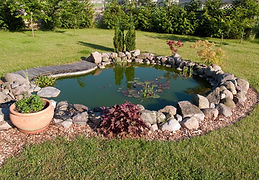

Telephone: 01335372075
8am-5pm Monday to Friday
Puddling Clay

Locally sourced, our high quality Woodfields Puddling Clay is an environmentally friendly, versatile product that has many uses, including lining ponds, home flood defences, making pizza ovens and well dressings as well as large commercial projects such as flood defences and lining the British Waterways canal system. Hydrated and ready to use Woodfields Puddling Clay is like putty which can be applied manually or mechanically.
We recommend a depth of 200 – 300mm of puddling clay depending on the size of the pool you are forming to produce an impermeable barrier and prevent leaks.


In years gone by ponds have been formed using sheep fenced on the the area using the action of the sheeps feet tredging round and round which has puddled the clay in to position. Nowadays large rolling machines are used but the rollers are still called sheeps feet.




Here is a caption from Valarie Porters book The Pond Book clearly describing the ways used in the past and present.



WE HAVE BEEN SELLING THIS PRODUCT FOR MANY YEARS AND HAVE NOW BUILT UP A PRESTIGIOUS CLIENT LIST, PLEASE BUY WITH CONFIDENCE OR CALL US IF YOU HAVE ANY QUESTIONS.
Puddling is used in maintaining canals or reservoirs on permeable ground. The technique of puddling and its use was developed by early canal engineer James Brindley; it is considered his greatest contribution to engineering.
This processed material was used extensively in UK canal construction in the period starting circa 1780. Starting about 1840 puddle clay was used more widely as the water-retaining element (or core) within earth fill dams, particularly in the Pennines. Its usage in UK dams was superseded about 1960 by the use of rolled clay in the core, and better control of moisture content.
A considerable number of early notable dams were built in that era and they are now sometimes referred to as the 'Pennines embankment' type. These dams are characterized by a slender vertical puddle clay core supported on both sides by earthfill shoulders of more heterogeneous material. To control under-seepage through the natural foundation below the dam, the Pennines embankments generally constructed a puddle clay-filled cutoff trench in rock directly below the central core. Later construction often used concrete to fill the cutoff trench.
To make puddle, clay or heavy loam is chopped with a spade and mixed into a plastic state with water and sometimes coarse sand or grit to discourage excavation by moles or water voles. The puddle is laid about 10 inches (25 cm) thick at the sides and nearly 3 ft (0.91 m) thick at the bottom of a canal, built up in layers. Puddle has to be kept wet in order to remain waterproof so it is important for canals to be kept filled with water.
The clay is laid down with a tool called a 'punner', or 'pun', a large rectangular block on a handle about 5 feet (1.5 m) long, or trodden down, or compacted by some other means (e.g. by an excavator using the convex outside of its scoop, or, historically, by driving cattle across the area).
_edited_edited.jpg)



